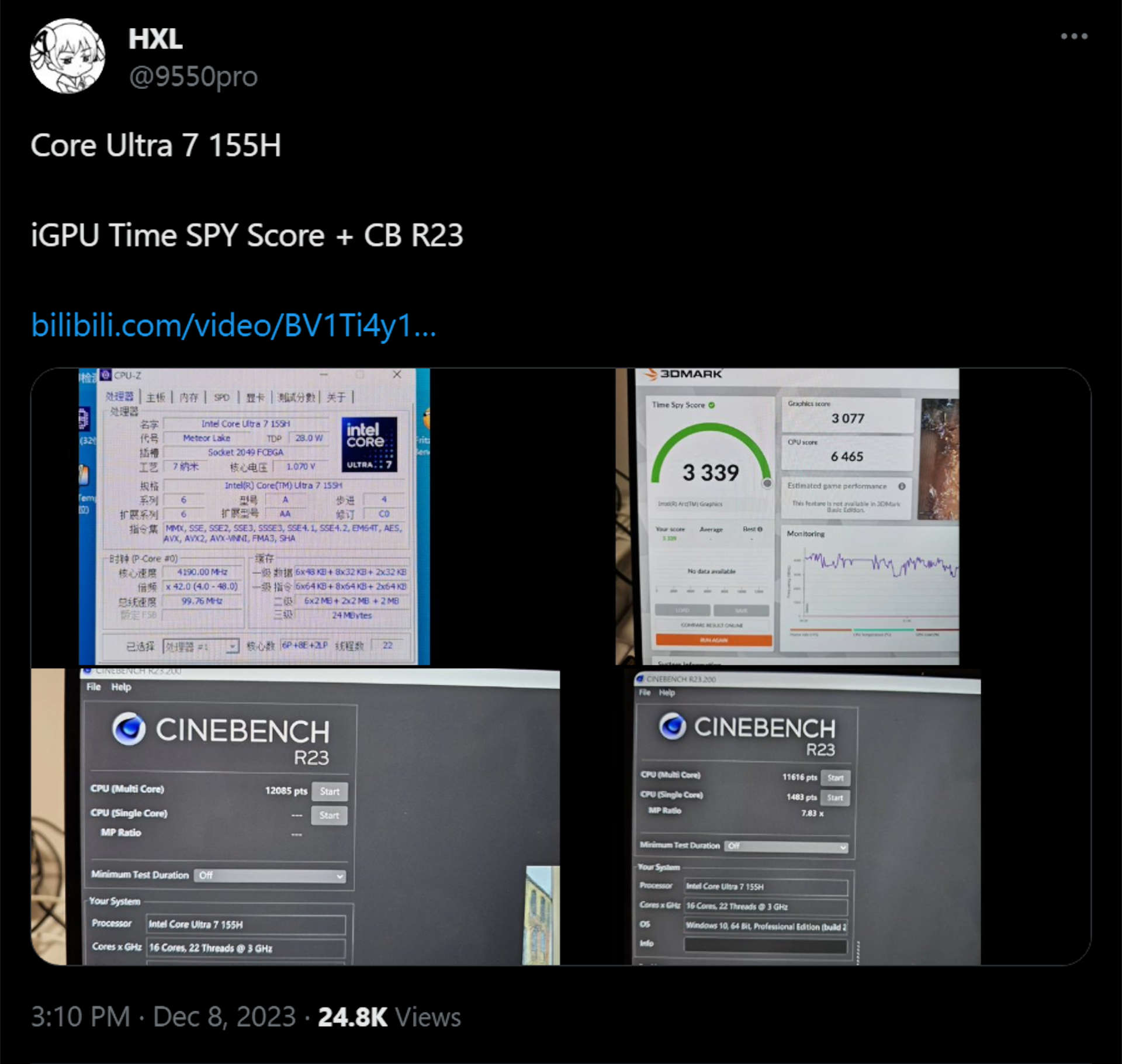[ad_1]
With the anticipated launch of Intel’s Meteor Lake structure being simply across the nook, benchmark scores are getting leaked left, proper, and centre. A 3DMark Time Spy check for a Core 7 Extremely 155H places it barely quicker than AMD’s Ryzen Z1 Excessive, which is utilized in numerous handheld gaming units. On condition that they’ve the identical energy restrict, it means that Workforce Purple may not have the pocket PC market all to itself in 2024.
I noticed this snippet of knowledge on X/Twitter, as posted by recurring leaker HXL. The screenshots reportedly present some benchmark outcomes for a 28W Core 7 Extremely 155H. This CPU is predicated on Intel’s forthcoming Meteor Lake structure, which contains a number of tiles for graphics, compute, IO, and normal housekeeping duties.
The compute tile homes six P-cores and eight E-cores, 22 threads in complete, with an additional two E-cores tucked away in one other tile. There’s much less information in regards to the GPU tile nevertheless it’s typically thought to have eight Xe cores and if we assume that Intel hasn’t modified the construction of its Arc graphics design for Meteor Lake, that is a complete of 1,024 shaders.
Anyway, the essential bit is that the chip achieved a Time Spy results of 3,339 and the picture exhibits a graphics rating of three,077 and a CPU rating of 6,465. To see what these figures are like, I ran the identical benchmark on the Asus ROG Ally, which sports activities AMD’s Ryzen Z1 Excessive APU.
You’ll be able to see in my Time Spy outcomes of that run the Asus handheld received an general rating of three,150 whereas the graphics rating was 2,834 and the CPU rating was 8,574. These figures have been achieved with the Ally docked and operating in its 30W Turbo mode, in order that’s pretty much as good as it may get for the ROG system. Taken on face worth, the Z1 Excessive produced a 33% higher CPU end result however an 8% decrease graphics rating.

AMD’s processor has eight Zen 4 cores and if Time Spy is being run completely on the Meteor Lake P-cores, this may clarify why there is a 33% distinction between the 2. If the E-cores are getting used, then it is a completely different story, and we might have to know much more about what is going on on with the clock speeds in the course of the checks to analyse it additional.
Intel’s Arc GPUs might be fairly twitchy with regards to gaming efficiency, particularly in older DirectX 9 and 10 video games, nevertheless it’s typically high-quality in newer ones, particularly with the fixed driver improvement. Time Spy is fairly heavy with shaders and the Alchemist structure is nice in these conditions; nevertheless, that does not at all times translate to being the identical in precise video games.
Certainly, the Alchemist GPUs have been tuned for 3DMark round launch and their artificial benchmarks instructed a really completely different story to the precise per-game benchmarks. That delta has been considerably slashed with latest driver releases, nevertheless.
The Arc tile being examined right here does not appear to be massively higher than the Radeon 780M within the Z1 Excessive, however a minimum of it is on par on this specific check. Actual-time gameplay will present a broad vary of variations however as a tough gauge, the Time Spy end result might be fairly near how issues will probably be on common.
The X/Twitter put up additionally exhibits some Cinebench R23 outcomes, with the Core 7 Extremely 155H getting a multicore rating of 11,616 and a single core of 1,483. By comparability, the ROG Ally received 13,896 and 1,717, respectively. That places Intel’s chip 14 to 16% behind AMD’s nevertheless it’s nearer in efficiency than within the Time Spy check.
In fact, there isn’t any option to confirm the claimed end result for the Core 7 Extremely 155H but when we assume that it is appropriate and consultant of what the chip can truly do, it isn’t too unhealthy for a 28W processor. For me, it is a super candidate for use in a handheld gaming PC, as uncooked CPU efficiency is much less essential than outright graphics energy.
Competitors in any phase is nice for the patron, so if Intel can produce these Meteor Lake processors on the similar value as AMD can churn out its APUs, then we might see some new handheld PCs in 2024 sporting Intel processors.
We all know that Emdoor is actually toying with the thought and the general gaming expertise with a Meteor Lake laptop computer is fairly encouraging for the scale of the GPU inside. I can not wait to see what new units come out subsequent 12 months, as though I am a beginner to this entire handheld factor, I am changing into more and more hooked on pocket PCs!
[ad_2]
Source link

